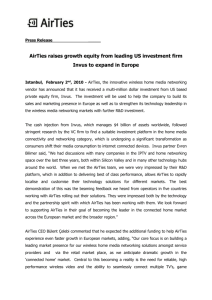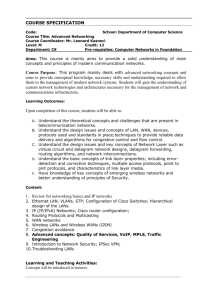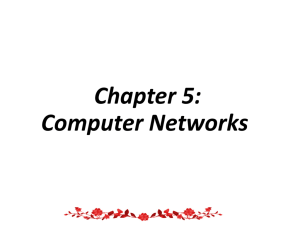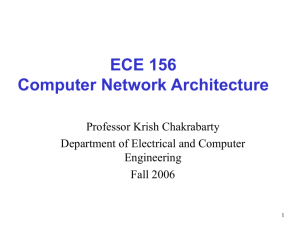Section 7
advertisement
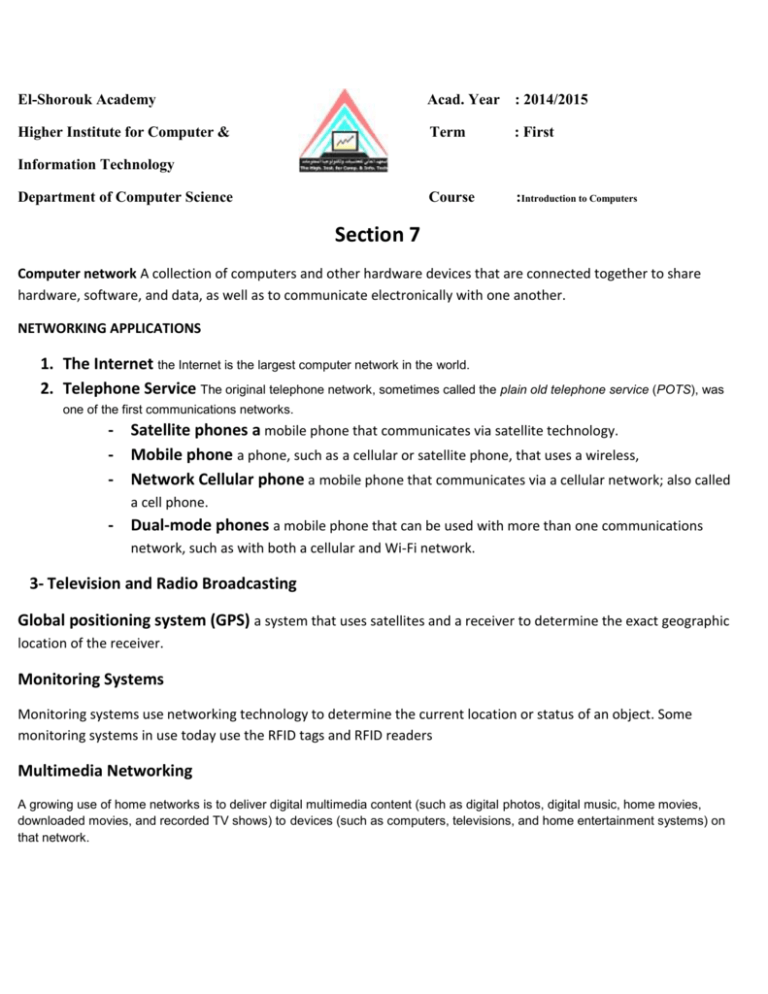
El-Shorouk Academy Acad. Year : 2014/2015 Higher Institute for Computer & Term : First Course :Introduction to Computers Information Technology Department of Computer Science Section 7 Computer network A collection of computers and other hardware devices that are connected together to share hardware, software, and data, as well as to communicate electronically with one another. NETWORKING APPLICATIONS 1. The Internet the Internet is the largest computer network in the world. 2. Telephone Service The original telephone network, sometimes called the plain old telephone service (POTS), was one of the first communications networks. - Satellite phones a mobile phone that communicates via satellite technology. - Mobile phone a phone, such as a cellular or satellite phone, that uses a wireless, - Network Cellular phone a mobile phone that communicates via a cellular network; also called a cell phone. - Dual-mode phones a mobile phone that can be used with more than one communications network, such as with both a cellular and Wi-Fi network. 3- Television and Radio Broadcasting Global positioning system (GPS) a system that uses satellites and a receiver to determine the exact geographic location of the receiver. Monitoring Systems Monitoring systems use networking technology to determine the current location or status of an object. Some monitoring systems in use today use the RFID tags and RFID readers Multimedia Networking A growing use of home networks is to deliver digital multimedia content (such as digital photos, digital music, home movies, downloaded movies, and recorded TV shows) to devices (such as computers, televisions, and home entertainment systems) on that network. Videoconferencing, Collaborative Computing, and Telecommuting Videoconferencing is the use of networking technology to conduct real-time, face-to-face meetings between individuals physically located in different places. Telecommuting The use of computers and networking technology to enable an individual to work from a remote location. Telemedicine The use of networking technology to provide medical information and services. Telesurgery A form of robot-assisted surgery in which the doctor’s physical location is different from the patient’s physical location and the doctor controls the robot remotely over the Internet or another network. NETWORK CHARACTERISTICS Wired vs. Wireless Networks Wired network A network in which computers and other devices are connected to the network via physical cables. Wireless network A network in which computers and other devices are connected to the network without physical cables; data is typically sent via radio waves. Network Topologies Star network All the networked devices connect to a central device Bus networks A network consisting of a central cable to which all network devices are attached. Mesh network A network in which there are multiple connections between the devices on the network so that messages can take any of several possible paths Network Architectures Client-server networks include both clients (computers and other devices on the network that request and utilize network resources) and servers (computers that are dedicated to processing client requests). A peer-to-peer (P2P) network, a central server is not used Instead, all the computers on the network work at the same functional level, and users have direct access to the computers and other devices attached to the network. Network Size and Coverage Area Personal area network (PAN) A network that connects an individual’s personal devices that are located close together. Local Area Networks (LANs) a network that covers a relatively small geographical area, such as a home, office building, or school. Metropolitan area network (MAN) is a network designed to service a metropolitan area, typically a city or county A wide area network (WAN) is a network that covers a large geographical area. Typically, a WAN consists of two or more LANs that are connected together using communications technology. Intranets and Extranets Intranet A private network that is set up similar to the Internet and is accessed via a Web browser. Extranet An intranet that is at least partially accessible to authorized outsiders. Virtual private network (VPN). A private, secure path over the Internet that provides authorized users a secure means of accessing a private network via the Internet. DATA TRANSMISSION CHARACTERISTICS The term bandwidth refers to the amount of data that can be transferred (such as over a certain type of networking medium) in a given time period. Analog vs. Digital Signals Digital signals, in which data is represented by only two discrete states: 0s and 1s Analog signals, such as those used by the conventional telephone system, represent data with continuous waves Transmission Type and Timing Serial transmission, data is sent one bit at a time, one after the other along a single path Parallel transmission the message is sent at least one byte at a time, with each bit in the byte taking a separate path Synchronous transmission data is organized into groups or blocks of data, which are transferred at regular, specified intervals. Asynchronous transmission data is sent when it is ready to be sent, without being synchronized. To identify the bits that belong in each byte, a start bit and stop bit are used at the beginning and end of the byte, respectively Isochronous transmission data is sent at the same time as other related data to support certain types of real-time applications that require the different types of data to be delivered at the proper speed for that application. Simplex transmission data travels in a single direction only Half-duplex transmission data can travel in either direction, but only in one direction at a time Full-duplex transmission data can move in both directions at the same time (like a telephone). Delivery Method Circuit switching, a dedicated path over a network is established between the sender and receiver and all data follows that path from the sender to the receiver Packet switching, messages are separated into small units called packets. Packets contain information about the sender and the receiver, the actual data being sent, and information about how to reassemble the packets to reconstruct the original message. Packets travel along the network separately, based on their final destination, network traffic, and other network conditions. When the packets reach their destination, they are reassembled in the proper order Broadcasting, in which data is sent out (typically in packets) to all nodes on a network and is retrieved only by the intended recipient. Broadcasting is used primarily with LANs. NETWORKING MEDIA Wired Networking Media A twisted-pair cable - is made up of pairs of thin strands of insulated wire twisted together the least expensive type of networking cable and has been in use the longest Used inside most homes for telephone communications. Coaxial cable (also known as coax) - Was originally developed to carry a large number of high-speed video transmissions at one time, such as to deliver cable TV service. - consists of a relatively thick center wire surrounded by insulation and then covered with a shield of braided wire to block electromagnetic signals from entering the cable - commonly used today in computer networks, for short-run Fiber-optic cable - is the newest and fastest of these three types of wired transmission media transfers data represented by light pulses at speeds of billions of bits per second Wireless Networking Media Cellular radio transmissions are used with cell phones and are sent and received via cellular (cell) towers—tall metal poles with antennas on top. Microwaves - Are high-frequency radio signals that can send large quantities of data at high speeds over long distances signals can be sent or received using microwave stations or communications satellites Microwave stations are earth-based stations that can transmit microwave signals directly to each other over distances of up to about 30 miles. Communications satellites - are space-based devices launched into orbit around the earth to receive and transmit microwave signals to and from earth Infrared (IR) Transmissions - Sends data as infrared light rays over relatively short distances. Like an infrared television remote control, infrared technology requires line-of-sight transmission. COMMUNICATIONS PROTOCOLS AND NETWORKING STANDARDS A protocol is a set of rules to be followed in a specific situation; TCP/IP is the protocol used for transferring data over the Internet and actually consists of two protocols Transmission Control Protocol (TCP), which is responsible for the delivery of data Internet Protocol (IP), which provides addresses and routing information. Ethernet (802.3) is the most widely used standard for wired networks. It is typically used with LANs that have a star topology and can be used in conjunction with twisted-pair, coaxial, or fiber-optic cabling Wi-Fi (802.11) A widely used networking standard for medium-range wireless networks. WiMAX An emerging wireless networking standard that is faster and has a greater range than Wi-Fi. Mobile WiMAX A version of WiMAX designed to be used with mobile phones. Bluetooth A networking standard for very short-range wireless connections; the devices are automatically connected once they get within the allowable range. Wireless USB A wireless version of USB designed to connect peripheral devices. Ultra Wideband (UWB) A networking standard for very short-range wireless connections among multimedia devices. WirelessHD (WiHD) An emerging wireless networking specification designed for connecting home consumer devices. TransferJet A networking standard for very short-range wireless connections between devices; devices need to touch in order to communicate. Network adapter A network interface, such as an expansion card or external network adapter. Network interface card (NIC) an expansion card through which a computer can connect to a network. Modem. A device that enables a computer to communicate over analog networking media, such as connecting to the Internet via telephone lines. Switch. A device used to connect multiple devices on a single (typically wired) network; forwards packets to only the intended recipient. Router A device that connects multiple networks together; routes packets to their next location in order to efficiently reach their destination. Wireless access point A device on a wireless network that connects wireless devices to that network. Wireless router. A router with a built-in wireless access point; most often used to connect wireless devices to a network and an Internet connection and often contains a built-in switch. Bridge A device used to bridge or connect two LANs; most often used to connect wired devices wirelessly to a network. Repeater. A device on a network that amplifies signals. Range extender. A repeater for a wireless network. Antenna. A device used for receiving or sending radio signals; often used to increase the range of a network. A multiplexer combines the transmissions from several different devices and sends them as one message A concentrator is a type of multiplexer that combines multiple messages and sends them via a single transmission medium in such a way that all the individual messages are simultaneously active, instead of being sent as a single combined message. Question 1. Computer network A collection of computers and other hardware devices that are connected together to share hardware, software, and data, as well as to communicate electronically with one another. 2. Antenna A device used for receiving or sending radio signals; often used to increase the range of a network. 3. Switch A device used to connect multiple devices on a single (typically wired) network; forwards packets to only the intended recipient. 4. A networking standard for very short-range wireless connections; the devices are automatically connected once they get within the allowable range. 5. Mesh network A network in which there are multiple connections between the devices on the network so that messages can take any of several possible paths. 6. WiMAX An emerging wireless networking standard that is faster and has a greater range than Wi-Fi. 7. Ethernet A networking protocol that uses packet switching to facilitate the transmission of messages; the protocol used with the Internet. 8. Global positioning system (GPS) A system that uses satellites and a receiver to determine the exact geographic location of the receiver. 9. Digital transmission A type of data transmission where the data is represented by 0s and 1s. 10. TCP/IP A widely used wired LAN networking standard.

